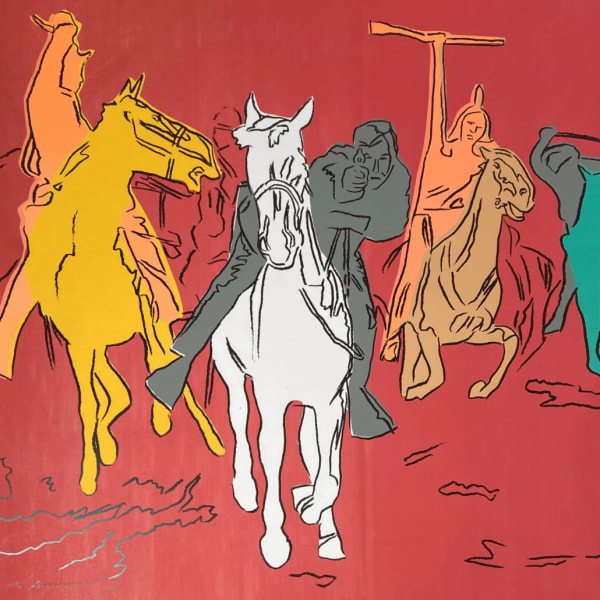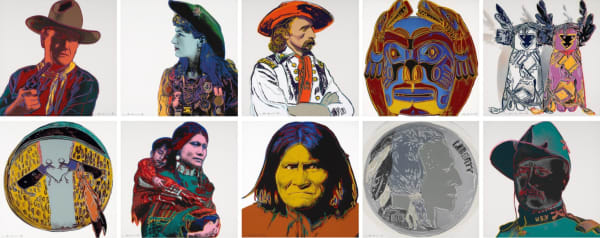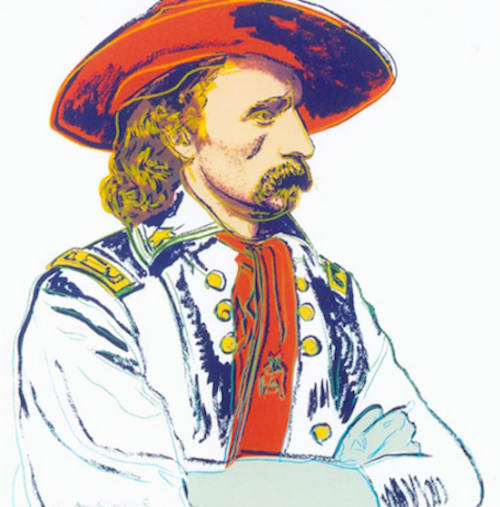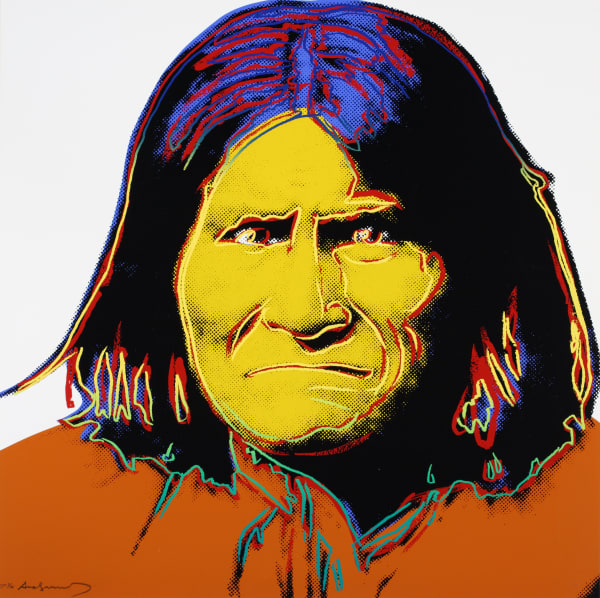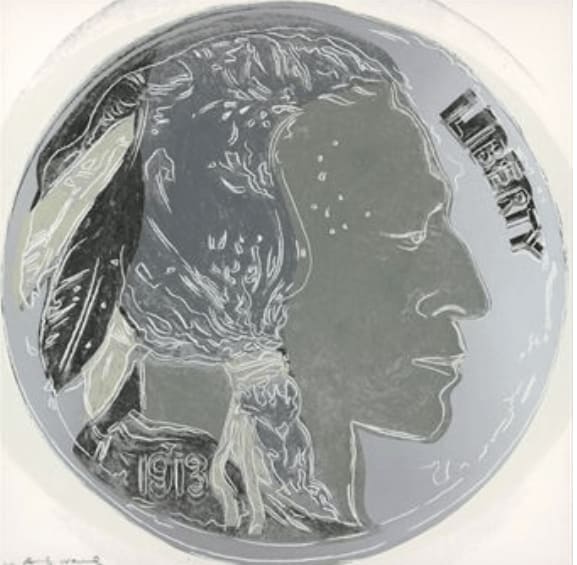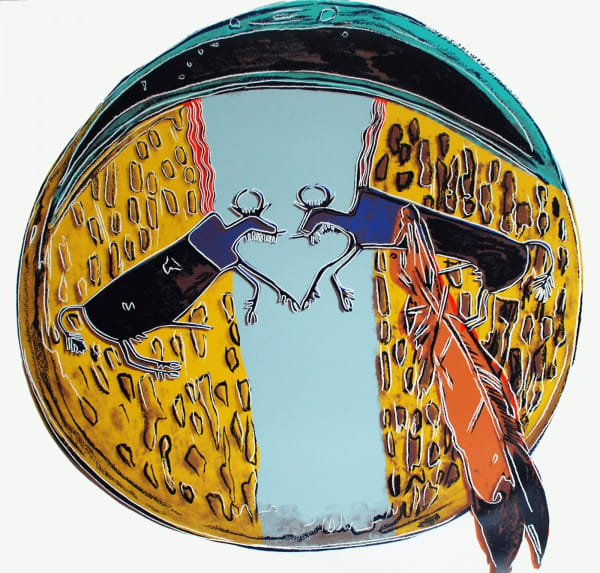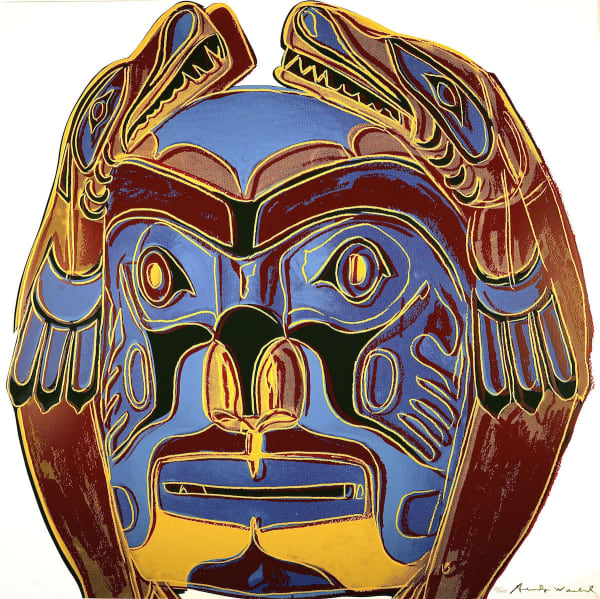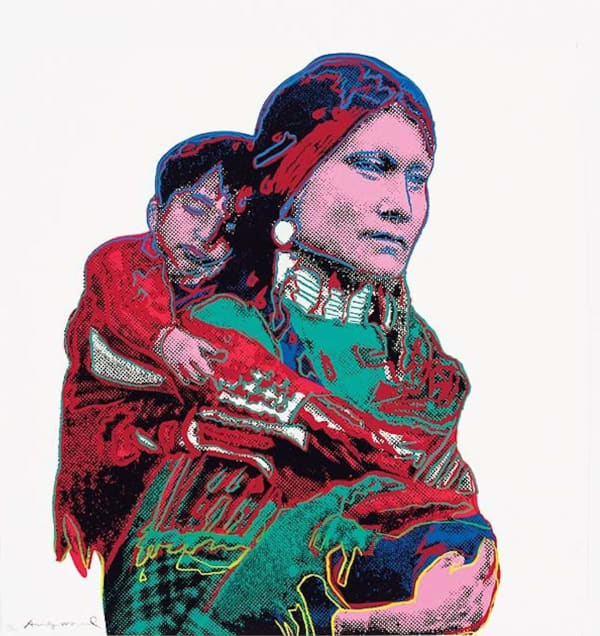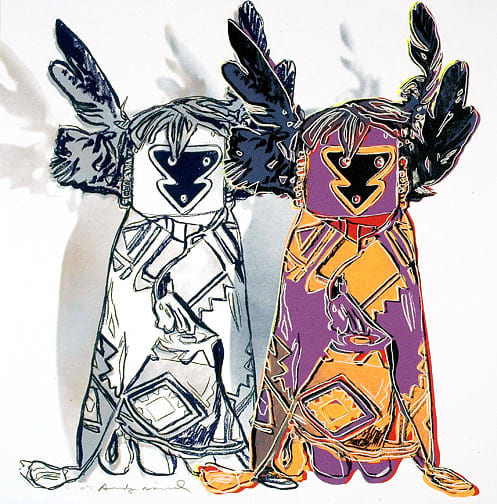
Andy Warhol
91.4 x 91.4 cm
Andy Warhol's John Wayne FS. II 377 print is a captivating piece from his Cowboys and Indians series, which he created in the 1980s. This series was a departure from his earlier works centered around consumer products and celebrity portraits, marking a shift towards exploring themes of American identity and mythology.
In the Cowboys and Indians series, Warhol examined iconic figures from American history and popular culture, reinterpreting them through his distinctive style of bold colors and repetitive imagery. John Wayne, an enduring symbol of rugged masculinity and the American West, was a fitting subject for Warhol's exploration of myth and legend.
Warhol's portrayal of John Wayne in this series captures the essence of the actor's persona: stoic, larger than life, and emblematic of a bygone era of Hollywood. The print depicts Wayne in his signature cowboy attire, complete with a cowboy hat and bandana, staring confidently into the distance. Warhol's use of bright, contrasting colors and graphic elements lends a sense of dynamism to the image, while also emphasizing the larger-than-life status of the subject.
Through his depiction of John Wayne, Warhol not only celebrates the actor's cultural significance but also interrogates the myths and ideals associated with the American West. The cowboy archetype, embodied by Wayne and other Hollywood icons, often symbolizes themes of heroism, individualism, and frontier spirit. However, Warhol's portrayal hints at a more complex narrative, inviting viewers to reconsider the romanticized notions of the Wild West and explore the contradictions inherent in American identity.
Moreover, by incorporating John Wayne into his broader exploration of American iconography, Warhol invites reflection on the intersection of celebrity culture, mass media, and national identity. Wayne, as a quintessential American hero, exemplifies the influence of media representations in shaping collective perceptions of heroism and identity.
Overall, Andy Warhol's John Wayne FS. II 377 from the Cowboys and Indians series is a compelling exploration of American mythology and celebrity culture. Through his distinct visual language, Warhol invites viewers to reevaluate familiar icons and consider the complex layers of meaning embedded within them.
For more information on John Wayne FS. II 377 or to buy John Wayne FS. II 377 contact our galleries using the form below.-
 Andy WarholAction Picture F.S. II 375, from Cowboys and Indians, 1986
Andy WarholAction Picture F.S. II 375, from Cowboys and Indians, 1986 -
 Andy WarholAnnie Oakley F.S. II 378, from Cowboys and Indians , 1986
Andy WarholAnnie Oakley F.S. II 378, from Cowboys and Indians , 1986 -
 Andy WarholBuffalo Nickel F.S. II 374, from Cowboys and Indians, 1986
Andy WarholBuffalo Nickel F.S. II 374, from Cowboys and Indians, 1986 -
 Andy WarholCowboys and Indians F.S. II 377-386 Cowboys and Indians, 1986
Andy WarholCowboys and Indians F.S. II 377-386 Cowboys and Indians, 1986 -
 Andy WarholGeneral Custer F.S. II 379, from Cowboys and Indians, 1986
Andy WarholGeneral Custer F.S. II 379, from Cowboys and Indians, 1986 -
 Andy WarholGeronimo F.S. II 384, from Cowboys and Indians, 1986
Andy WarholGeronimo F.S. II 384, from Cowboys and Indians, 1986 -
 Andy WarholIndian Head Nickel F.S.II 385, from Cowboys and Indians , 1986
Andy WarholIndian Head Nickel F.S.II 385, from Cowboys and Indians , 1986 -
 Andy WarholPlains Indian Shield F.S. II 382, from Cowboys and Indians , 1986
Andy WarholPlains Indian Shield F.S. II 382, from Cowboys and Indians , 1986 -
 Andy WarholNorthwest Coast Mask F.S. II 380, from Cowboys and Indians , 1986
Andy WarholNorthwest Coast Mask F.S. II 380, from Cowboys and Indians , 1986 -
 Andy WarholTeddy Roosevelt F.S. II 386, from Cowboys and Indians , 1986
Andy WarholTeddy Roosevelt F.S. II 386, from Cowboys and Indians , 1986 -
 Andy WarholMother and Child F.S. II 383, from Cowboys and Indians , 1986
Andy WarholMother and Child F.S. II 383, from Cowboys and Indians , 1986 -
 Andy WarholKachina Dolls F.S. II 381, from Cowboys and Indians , 1986
Andy WarholKachina Dolls F.S. II 381, from Cowboys and Indians , 1986 -
 Andy WarholWar Bonnet Indian F.S. II 373, from Cowboys and Indians, 1986
Andy WarholWar Bonnet Indian F.S. II 373, from Cowboys and Indians, 1986 -
 Andy WarholPlains Indian Shield F.S. II 382, from Cowboys and Indians , 1986
Andy WarholPlains Indian Shield F.S. II 382, from Cowboys and Indians , 1986 -
 Andy WarholNorthwest Coast Mask F.S. II 380, from Cowboys and Indians , 1986
Andy WarholNorthwest Coast Mask F.S. II 380, from Cowboys and Indians , 1986 -
 Andy WarholKachina Dolls F.S. II 381, from Cowboys and Indians , 1986
Andy WarholKachina Dolls F.S. II 381, from Cowboys and Indians , 1986 -
 Andy WarholAnnie Oakley F.S. II 378, from Cowboys and Indians , 1986
Andy WarholAnnie Oakley F.S. II 378, from Cowboys and Indians , 1986
Join our mailing list
* denotes required fields
We will process the personal data you have supplied in accordance with our privacy policy (available on request). You can unsubscribe or change your preferences at any time by clicking the link in our emails.
This website uses cookies
This site uses cookies to help make it more useful to you. Find out more about cookies.
